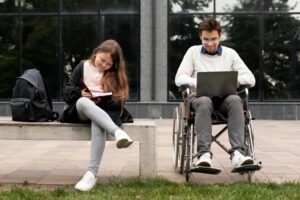In-house mentoring and coaching
Materials
1. Introduction
In today’s rapidly evolving educational landscape, the imperative to foster diversity, equity, and inclusion (DEI) within higher education (HE) institutions has never been more critical. As educational demographics continue to diversify and societal expectations for equity and inclusion grow, HE institutions must adapt to meet the needs of all students. In this context, in-house mentoring and coaching programs tailored for teachers within the inclusive domain emerge as vital mechanisms for advancing DEI efforts. These programs offer personalized support and guidance to faculty members as they navigate the complexities of creating inclusive learning environments and addressing the diverse needs of students. By deepening educators’ understanding of DEI principles, enhancing their cultural competence, and equipping them with the knowledge and skills needed to promote equity and access, in-house mentoring and coaching programs play a pivotal role in transforming the culture of higher education and advancing DEI goals.
2. The difference between mentoring and coaching
Mentoring and coaching are often mentioned in the same breath, but they serve distinct purposes. In general, mentoring is an informal association aimed at building a two-way, mutually beneficial relationship for long-term career movement. It’s about sharing knowledge, experience, and advice to guide a mentee towards reaching their full potential (Jones & Smith, 2022). On the other hand, coaching, as defined by the International Coaching Federation (ICF), is a partnership that involves a thought-provoking and creative process, inspiring clients to maximize their personal and professional potential (Jones & Smith, 2022). Coaching is more structured and goal-oriented, focusing on specific improvements in performance and the development of particular skills (International Coaching Federation, 2024; Jones & Smith, 2022).
If we apply these definitions to the higher education (HE) environment, we could state that mentoring primarily focuses on identifying and nurturing an individual’s overall potential (Eby, L.T.; Rhodes, J.E.; Allen, 2007). It entails a long-term partnership wherein the learner establishes goals that may evolve over time. Both the goals and the process are driven by the learner, and the mentor aids the mentee in gaining insight and knowledge by facilitating intrinsic observation of their own experiences (Gamage et al., 2021). Therefore, in the mentoring process, a mentor shares knowledge, skills, and experiences to assist another person in their development and growth. It’s a relationship that often endures for an extended period, sometimes spanning years. Mentoring is directive, with the mentor actively guiding the mentee (Reitman & Benatti, 2021).
On the other hand, coaching is primarily focused on enhancing performance in a particular skill area, typically in the short term. The coach typically sets the goals, or at least the intermediate or sub-goals, either independently or with the client’s input, while the client is responsible for the objectives, and the coach oversees the execution (Gamage et al., 2021). Therefore, a coach offers guidance to a client on specific goals, aiding them in reaching their full potential. Coaching is more structured and goal-oriented. Coaches ask questions, enabling clients to reflect and discover their solutions (Reitman & Benatti, 2021).
Table 1. Difference between characteristics of Mentoring and Coaching (PushFar Ltd., 2021; Reitman & Benatti, 2021; Vakani, 2017)
| Characteristics | Mentoring | Coaching |
| Duration | Typically long-term, some mentoring relationships last for years. | Coaching engagements are often shorter and more focused. |
| Qualifications | No formal qualifications are required for mentors, making it easy for organizations to initiate mentoring programs. | While coaching training is recommended, formal qualifications are not mandatory. |
| Approach | Directive approach, where mentors share their expertise, experience, and skills. | Non-directive approach, where coaches ask questions, encourage reflection and guide coachees toward solutions. |
| Formalization | It’s less formalized. | Coaching agreements set ground rules. |
| Impact on Clients | Helps clients acclimate to, for example, university teaching and develop positive relationships with SEND. | Enhances specific skills and supports academic achievement. |
| Overall Benefits | Provides a broader perspective on career growth and personal development. | Focuses on targeted outcomes and skill improvement. |
In summary, while mentoring and coaching share common ground, understanding their distinct features is essential for maximizing their impact in higher education. Both practices contribute to individual growth, student success, and organizational excellence.
3. In-house mentoring and coaching in HE
In-house mentoring and coaching programs for teachers in higher education (HE) within the inclusive domain serve as invaluable resources for advancing diversity, equity, and inclusion (DEI) efforts within academic institutions. These programs are designed to provide personalized support and guidance to faculty members as they navigate the complexities of creating inclusive learning environments and addressing the diverse needs of students. In-house mentoring and coaching initiatives aim to deepen educators’ understanding of DEI principles, enhance their cultural competence, and equip them with the knowledge and skills needed to promote equity and access for all students. (American Institutes for Research, 2015; Kutsyuruba & Godden, 2019)
Mentoring and coaching programs in the inclusive domain offer distinct yet complementary approaches to supporting teachers’ professional growth and development. Mentoring typically involves a more experienced faculty member, known as a mentor, providing guidance, advice, and support to a less experienced colleague, known as a mentee. Mentors share their knowledge, expertise, and insights with mentees, helping them navigate institutional structures, develop effective teaching strategies, and foster inclusive classroom environments. (American Institutes for Research, 2015; Kutsyuruba & Godden, 2019)
On the other hand, coaching focuses on facilitating the growth and development of educators through a process of inquiry, reflection, and goal-setting. Coaches, often trained professionals with expertise in DEI, work collaboratively with teachers to identify areas for improvement, set goals, and develop action plans to enhance their teaching effectiveness and promote inclusivity. Coaching provides a supportive and nonjudgmental space for educators to explore their beliefs, assumptions, and biases and to develop strategies for creating more equitable and accessible learning experiences for students. (American Institutes for Research, 2015; Kutsyuruba & Godden, 2019)
One of the primary objectives of in-house mentoring and coaching programs in the inclusive domain is to deepen teachers’ understanding of diversity, equity, and inclusion issues in higher education. Mentors and coaches facilitate discussions, workshops, and training sessions on topics such as unconscious bias, privilege, intersectionality, and inclusive pedagogy, helping educators critically examine their beliefs and practices and identify opportunities for growth and improvement. (American Institutes for Research, 2015; Kutsyuruba & Godden, 2019)
Furthermore, in-house mentoring and coaching initiatives provide teachers with ongoing support and feedback as they implement inclusive teaching practices in their classrooms. Mentors and coaches offer encouragement, validation, and constructive criticism to help educators overcome challenges, leverage their strengths, and refine their instructional approaches. By providing personalized guidance and support, mentoring and coaching enable teachers to adapt to the diverse needs of their students and create learning environments that are welcoming, supportive, and accessible to all. (American Institutes for Research, 2015; Kutsyuruba & Godden, 2019)
In-house mentoring and coaching programs also facilitate sharing best practices and innovative strategies for promoting diversity and equity in higher education. Mentors and coaches collaborate with teachers to identify evidence-based interventions, instructional resources, and assessment tools that foster inclusivity and accessibility. Through peer learning communities, workshops, and professional development opportunities, educators have the opportunity to exchange ideas, learn from each other’s experiences, and collectively work towards creating more equitable and inclusive educational experiences for all students. (American Institutes for Research, 2015; Kutsyuruba & Godden, 2019)
Moreover, in-house mentoring and coaching initiatives empower teachers to become change agents and advocates for DEI within their academic departments and institutions. Mentors and coaches help educators develop leadership skills, build networks, and navigate institutional structures to effect positive change at the systemic level. By fostering a sense of agency and empowerment, mentoring and coaching inspire educators to collaborate with colleagues, engage in policy advocacy, and champion initiatives that promote equity, access, and social justice in higher education. (American Institutes for Research, 2015; Kutsyuruba & Godden, 2019)
Ultimately, in-house mentoring and coaching for teachers in the inclusive domain are integral to transforming the culture of higher education and advancing DEI goals within academic institutions. By providing personalized support, fostering collaboration, and empowering educators to enact meaningful change, mentoring and coaching programs contribute to creating more welcoming, inclusive, and equitable learning environments where all students can thrive and succeed. (American Institutes for Research, 2015; Kutsyuruba & Godden, 2019)
The in-house mentoring process consists of the following primary and general steps (Gamage et al., 2021; The Northern Territory Department of Education, 2014):
- Pairing: A more experienced educator (mentor) is paired with a less experienced colleague (mentee).
- Orientation: Both parties are oriented on the goals, expectations, and structure of the mentoring relationship.
- Goal-Setting: The mentee sets professional development goals with the mentor’s guidance.
- Observation and feedback: The mentor observes the mentee’s teaching practices and provides constructive feedback.
- Support: The mentor offers continuous support, sharing knowledge and expertise to help the mentee navigate institutional structures and develop effective teaching strategies.
- Professional development: The mentor facilitates the mentee’s participation in workshops and training sessions focused on DEI principles and inclusive pedagogy.
- Reflection: Regular reflection sessions are held to discuss progress, challenges, and future steps.
The In-house coaching process consists of the following primary and general steps (Gamage et al., 2021; Khusainova, 2023; NCSI, 2014):
- Identification of coaches: Trained professionals with expertise in DEI are identified to serve as coaches.
- Assessment: Coaches work with teachers to assess their current teaching practices and identify areas for improvement.
- Goal-setting: Teachers set specific goals for enhancing their teaching effectiveness and promoting inclusivity.
- Action planning: Coaches help teachers develop action plans to achieve their goals.
- Implementation: Teachers implement the strategies and practices discussed with their coaches in their classrooms.
- Ongoing support: Coaches provide ongoing support and feedback, creating a nonjudgmental space for teachers to explore their beliefs and biases.
- Evaluation: The effectiveness of the coaching is evaluated through observation and assessment of changes in teaching practices.
Both processes aim to create a supportive environment where educators can grow professionally, enhance their cultural competence, and effectively contribute to the institution’s DEI efforts. They involve personalized guidance, professional development opportunities, and a focus on creating inclusive learning environments that cater to the diverse needs of students.
4. Guidelines for conducting effective in-house mentoring and coaching
Creating effective in-house mentoring and coaching programs within higher education institutions requires a structured approach that fosters professional growth and supports the inclusive domain. Here are some guidelines to ensure the success of such initiatives (Jones & Smith, 2022; Vakani, 2017):
Establish clear objectives
- Define the specific goals of the mentoring and coaching programs.
- Align the objectives with the broader diversity, equity, and inclusion (DEI) strategy of the institution.
Select qualified mentors and coaches
- Choose mentors and coaches with proven expertise in DEI and teaching excellence.
- Ensure they have a commitment to fostering an inclusive educational environment.
Provide Training
- Offer comprehensive training for mentors and coaches to equip them with the necessary skills and knowledge.
- Include topics such as unconscious bias, privilege, intersectionality, and inclusive pedagogy.
Develop a Matching Process
- Create a thoughtful pairing system that matches mentors and mentees, coaches and educators based on shared interests, expertise, and professional development needs.
Set Up a Support System
- Implement a structure for ongoing support and supervision of mentors and coaches.
- Provide resources and materials to assist them in their roles.
Facilitate Goal-Setting and Action Planning
- Encourage mentees and educators to set clear, achievable goals.
- Assist them in developing action plans to meet these goals.
Monitor Progress and Provide Feedback
- Establish regular check-ins to monitor progress and provide feedback.
- Use these sessions to address challenges and celebrate successes.
Evaluate and Adapt
- Continuously evaluate the effectiveness of the mentoring and coaching programs.
- Be open to making adjustments based on feedback and outcomes.
Promote Collaboration and Sharing
- Create opportunities for participants to share experiences and learn from one another.
- Encourage the dissemination of best practices and innovative strategies within the community.
Foster a Culture of Inclusivity
- Ensure that the mentoring and coaching programs contribute to a culture that values and respects diversity.
- Empower participants to become advocates for DEI within their departments and the institution at large.
Implementing these guidelines can help create robust in-house mentoring and coaching programs that not only support the professional development of educators but also advance the DEI mission of higher education institutions.
Practical Example: Implementing Inclusive Mentoring and Coaching at XYZ University
Background: XYZ University is committed to promoting diversity, equity, and inclusion (DEI) within its academic community. Recognizing the importance of providing support for faculty members in their professional growth and inclusivity efforts, the university has decided to establish an in-house mentoring and coaching program.
Objective: The objective of this program is to create a structured support system that fosters professional development while advancing the institution’s DEI goals. By pairing experienced mentors and coaches with mentees and educators, the program aims to enhance teaching effectiveness and cultivate an inclusive learning environment.
Implementation: To ensure the success of the in-house mentoring and coaching program, XYZ University follows a structured approach based on the following guidelines:
Establish Clear Objectives: The objective is to increase faculty members’ awareness of inclusive teaching practices and support their implementation in the classroom.
Select Qualified Mentors and Coaches: Experienced faculty members who have demonstrated a commitment to DEI initiatives and have received training in inclusive pedagogy are selected as mentors and coaches.
Provide Training: Mentors and coaches participate in workshops on topics such as unconscious bias, privilege, intersectionality, and inclusive pedagogy.
Develop a Matching Process: Mentees are matched with mentors who have experience teaching similar subjects or working in related research areas.
Set Up a Support System: Regular meetings are scheduled for mentors and coaches to discuss their experiences, challenges, and successes.
Outcome: By implementing these guidelines, XYZ University successfully establishes a robust in-house mentoring and coaching program. Faculty members benefit from personalized support, guidance, and professional development opportunities, ultimately enhancing their teaching effectiveness and contributing to a more inclusive learning environment. The program’s success reflects the university’s commitment to DEI and its dedication to supporting the growth and well-being of its academic community.
More examples: Coaching and Mentoring in Higher Education Institutions A Case Study in Oman, 10+ Examples of successful mentoring programs, Advancing Inclusive Mentoring Through an Online Mentor Training Program and Coordinated Discussion Group, Evidence-based Practices in Mentoring Students with Disabilities: Four Case Studies
5. Conclusion
In conclusion, in-house mentoring and coaching programs represent indispensable pillars in the ongoing search for diversity, equity, and inclusion (DEI) within higher education institutions. As the landscape of higher education continues to evolve, the importance of these programs cannot be overstated. By providing personalized support, fostering collaboration, and empowering educators to enact meaningful change, in-house mentoring and coaching programs contribute significantly to creating inclusive, equitable, and welcoming learning environments where all students can thrive. Moving forward, it is imperative that HE institutions continue to invest in and expand these programs, ensuring that DEI remains at the forefront of educational priorities. Through sustained commitment and collective effort, in-house mentoring and coaching will continue to play a central role in shaping a brighter, more inclusive future for higher education.
References
American Institutes for Research. (2015). Teacher Induction and Mentoring Brief.
Eby, L.T.; Rhodes, J.E.; Allen, T. D. (2007). Definition and Evolution of Mentoring. In In The Blackwell Handbook of Mentoring (p. pp.7-20). Hoboken, NJ, USA, 2007.
Gamage, K. A. A., Perera, D. A. S., & Wijewardena, M. A. D. N. (2021). Mentoring and coaching as a learning technique in higher education: The impact of learning context on student engagement in online learning. Education Sciences, 11(10). https://doi.org/10.3390/educsci11100574
International Coaching Federation. (2024). Leading the Global Advancement of Coaching. https://coachingfederation.org/about
Jones, J., & Smith, H. A. (2022). A comparative study of formal coaching and mentoring programmes in higher education. International Journal of Mentoring and Coaching in Education, 11(2), 213–231. https://doi.org/10.1108/IJMCE-03-2021-0054
Khusainova, R. (2023). Introduce coaching principles into your work in four easy steps. https://www.timeshighereducation.com/campus/introduce-coaching-principles-your-work-four-easy-steps
Kutsyuruba, B., & Godden, L. (2019). The role of mentoring and coaching as a means of supporting the well-being of educators and students. International Journal of Mentoring and Coaching in Education, 8(4), 229–234. https://doi.org/10.1108/IJMCE-12-2019-081
NCSI. (2014). Effective Coaching: Improving Teacher Practice and Outcomes for All Learners. https://www.air.org/sites/default/files/NCSI_Effective-Coaching-Brief-508.pdf
PushFar Ltd. (2021). Mentoring vs Coaching: The Key Differences and Benefits. https://thrivementoring.reading.ac.uk/article/mentoring-vs-coaching-the-key-differences-and-benefits/
Reitman, A., & Benatti, S. (2021). Mentoring vs Coaching. https://www.td.org/insights/mentoring-versus-coaching-whats-the-difference
The Northern Territory Department of Education. (2014). A Reflective Guide to Mentoring and being a Teacher Mentor. https://education.nt.gov.au/__data/assets/pdf_file/0011/427583/2017_teachers_guide_to_effective_mentoring.pdf
Vakani, F. S. (2017). Coaching and Mentoring in Higher Education: a Step-By-Step Guide to Exemplary Practice. International Journal of Mentoring and Coaching in Education, 6(1), 78–79. https://doi.org/10.1108/IJMCE-12-2016-0076
4. Continuous Professional Development Addition
Continuous Professional Development for Inclusive Digital Teaching – Part 2
10 min
Participants will be able to:
- Understand the core concepts and principles of in-house mentoring and coaching.
- Perform effective in-house mentoring and coaching sessions based on their main characteristics.
in-house mentoring and coaching; process of mentoring and coaching








Funded by the European Union. Views and opinions expressed are however those of the author(s) only and do not necessarily reflect those of the European Union or the European Education and Culture Executive Agency (EACEA). Neither the European Union nor EACEA can be held responsible for them (2022- 1 -SI01 -KA220-HED-000088368).






